Haryana State Board HBSE 6th Class Maths Solutions Chapter 7 Fractions Intext Questions and Answers.
Haryana Board 6th Class Maths Solutions Chapter 7 Fractions Intext Questions
Try These (Page 175):
Question 1.
Show \(\frac{3}{5}\) on a number line.
Solution:
![]()
We divide the gap between 0 and 1 into 5 equal parts. \(\frac{3}{5}\) means 3 parts out of 5 parts as shown above.
![]()
Question 2.
Show \(\frac{1}{10}, \frac{0}{10}, \frac{5}{10}\) and \(\frac{10}{10}\) on a number line.
Solution:

We divide the gap between 0 and 1 into 10 equal parts. \(\frac{1}{10}\) means 1 part out of 10 parts as shown above.
\(\frac{0}{10}\) is the point zero whereas \(\frac{10}{10}\) is 1 whole, which can be shown by the points 0 and 1 respectively (as shown in Fig.).
Now, \(\frac{5}{10}\) means 5 parts out of 10 parts as shown in the Fig.
Question 3.
Can you show any other fraction between 0 and 1 ? Write 5 more fractions that you can show and depict them on the number line.
Solution:
Yes, we can show other fractions between 0 and 1
e.g., \(\frac{1}{8}, \frac{3}{8}, \frac{4}{8}, \frac{5}{8}, \frac{7}{8}\) are five more fractions between 0 and 1.
![]()
Question 4.
How many fractions are there between 0 and 1 ? Think, discuss and write you answer.
Solution:
There are an infinite number of fractions between 0 and 1.
Try These (Page 175):
Question 1.
Give a proper fraction :
(a) The numerator of which is 5 and denominator is 7.
(b) The denominator of which is 9 and numerator is 5.
(c) The numerator and denominator of which add. up to 10. How many frac¬tions of this kind, can you make ?
(d) The denominator of which is 4 more than the numerator. (Make any 5, how many more can you make ?)
Solution:
(a) \(\frac{5}{7}\)
(b) \(\frac{5}{9}\)
(c) \(\frac{1}{9}, \frac{2}{8}, \frac{3}{7}, \frac{4}{6}\) are four proper fractions of this kind.
(d) \(\frac{1}{5}, \frac{2}{6}, \frac{3}{7}, \frac{4}{8}, \frac{5}{9}\)
We can make an infinite number of such proper fractions.
Question 2.
A fraction is given.
How will you decide, by just looking at it, whether, the fraction is :
(a) Less than 1 ? (b) Equal to 1 ?
Solution:
(a) If numerator is less than the denominator, then the fracton is less than 1.
(b) If numerator is equal to the denominator, then the fraction is equal to 1.
![]()
Question 3.
Fill up, using one of these : ‘>\ ‘<’ or ‘=’.

Solution:
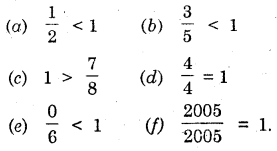
Try These (Page 177):
Question.
(a)Write 5 improper fractions with denominator 7 ?
(b) Write 5 improper fractions with numerator 11 ?
Solution:
(a) \(\frac{8}{7}, \frac{11}{7}, \frac{15}{7}, \frac{20}{7}, \frac{30}{7}\)
(b) \(\frac{11}{5}, \frac{11}{6}, \frac{11}{7}, \frac{11}{8}, \frac{11}{9}\)
Is the fraction \(\frac{11}{11}\) proper or improper ?
Answer:
\(\frac{11}{11}\) is an improper fraction.
Try These (Page 181)
Question 1.
Are \(\frac{1}{3}\) and \(\frac{2}{6}\) equivalent ? Give reason.
Solution:
Yes, because \(\frac{1}{3}=\frac{1 \times 2}{3 \times 2}=\frac{2}{6}\)
Question 2.
Are \(\frac{2}{5}\) and \(\frac{2}{7}\) equivalent ? Give reason.
Solution:
No, because \(\frac{2}{5} \neq \frac{2}{7}\)
Question 3.
Are \(\frac{2}{9}\) and \(\frac{6}{27}\) equivalent ? Give reason.
Solution:
Yes, because \(\frac{2}{9}=\frac{2 \times 3}{9 \times 3}=\frac{6}{27}\)
Question 4.
Give another example of 4 equivalent fractions.
Solution:
\(\frac{1}{2}, \frac{2}{4}, \frac{3}{6}, \frac{36}{72}\) -are all equivalent fractions.
Question 5.
Identify the fractions in each. Write down which fractions are equivalent ?

Solution:

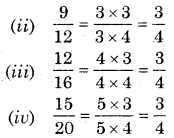
We see that all fractions are all equal. Hence, all fractions are equivalent.
![]()
Try These (Page 183) :
(a) Find five equivalent fractions of each :
(i) \(\)
(ii) \(\)
(iii) \(\)
(iv) \(\)
Solution:
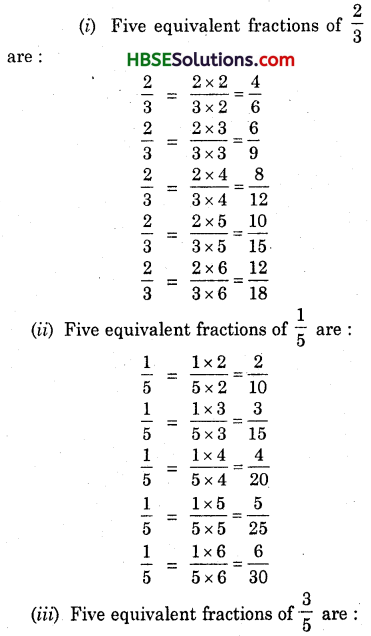
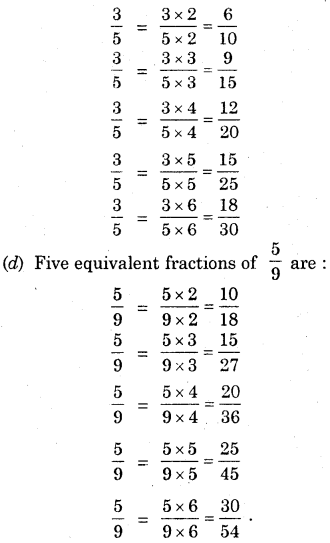
Try These (Page 187):
Question.
(a) Write the simplest form of
(i) \(\frac{15}{75}\)
(ii) \(\frac{16}{72}\)
(iii) \(\frac{17}{51}\)
(iv) \(\frac{42}{28}\)
(v) \(\frac{80}{24}\)
(b) Is \(\frac{169}{289}\) in its simplest form ?
Solution:
(a) (i) Factors of 15 are : 1, 3, 5, 15
Factors of 75 are : 1, 3, 5, 15, 25, 75
Common factors are : 1, 3, 5, 15
∴ The HCF of 15 and 75 is 15.
Now, \(\frac{15}{75}=\frac{15 \div 15}{75 \div 15}=\frac{1}{5}\)
![]()
(ii) Factors of 16 are : 1, 2, 4, 8, 16
Factors of 72 are : 1, 2, 3, 4, 6, 8, 9, 12, 18, 24, 36, 72
Common factors are : 1, 2, 4, 8.
∴ The HCF of 16 and 72 is 8.
Now, \(\frac{16}{72}=\frac{16 \div 8}{72 \div 8}=\frac{2}{9}\)
(iii) Factors of 17 are : 1, 17
Factors of 51 are : 1, 3, 17, 51
Common factors are : 1, 17
∴ The HCF of 17 and 51 is 17.
Now, \(\frac{17}{51}=\frac{17 \div 17}{51 \div 17}=\frac{1}{3}\)
(iv) Factors of 42 are : 1, 2, 3, 6, 7, 14, 21, 42
Factors of 28 are : 1, 2, 4, 7, 14, 28.
Common factors are : 1, 2, 7, 14.
∴ HCF of 42 and 28 is 14.
Now, \(\frac{42}{28}=\frac{42 \div 14}{28 \div 14}=\frac{3}{2}\)
(v) Factors of 80 are: 1, 2, 4, 5, 8, 10, 16, 20, 40, 80.
Factors of 24 are: 1, 2, 3, 4, 6, 8, 12, 24.
Common factors are: 1, 2, 4, 8
∴ HCF of 80 and 24 is 8.
Now, \(\frac{80}{24}=\frac{80 \div 8}{24 \div 8}=\frac{10}{3}\)
(b) ∵ HCF of 169 and 289 is 1.
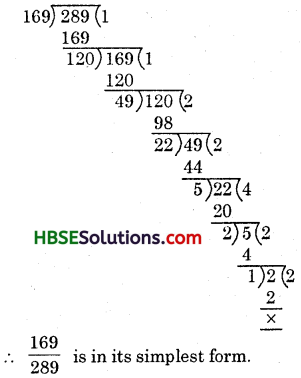
Try These (Page 191):
Question 1.
You get one fifth of a bottle of juice and your sister gets one-third of a bottle of juice. Who gets more ?
Solution:
One fifth of a bottle of juice = \(\frac{1}{5}\)
One third of a bottle of juice = \(\frac{1}{3}\)
Comparing \(\frac{1}{5}\) and \(\frac{1}{3}\), we find that \(\frac{1}{3}>\frac{1}{5}\)
Thus, your sister gets more juice.
![]()
Try These (Page 191):
Question 1.
Which is the larger fraction :
(i) \(\frac{7}{10} \text { or } \frac{8}{10}\)
(ii) \(\frac{11}{24} \text { or } \frac{13}{24}\)
(iii) \(\frac{17}{102} \text { or } \frac{12}{102}\)
Why are these comparisons easy to make ?
Solution:
(i) \(\frac{8}{10}\) is larger than \(\frac{7}{10}\)
(ii) \(\frac{13}{24}\) is larger than \(\frac{17}{102}\)
(iii) \(\frac{12}{102}\) larger than \(\frac{17}{102}\)
These comparisons are easy to make, because their denominators are same.
Question 2.
Write these in ascending and also in descending order :
(a) \(\frac{1}{8}, \frac{3}{8}, \frac{5}{8}, \frac{11}{8}, \frac{13}{8}\)
(b) \(\frac{1}{5}, \frac{3}{5}, \frac{4}{5}, \frac{7}{5}, \frac{11}{5}\)
(c) \(\frac{1}{7}, \frac{3}{7}, \frac{2}{7}, \frac{11}{7}, \frac{13}{7}, \frac{15}{7}\)
Solution:

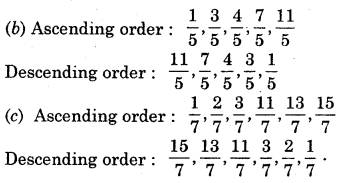
Try These (Page 193) :
Question 1.
Arrange the following in ascending and descending order:
(a) \(\frac{1}{12}, \frac{1}{23}, \frac{1}{5}, \frac{1}{7}, \frac{1}{50}, \frac{1}{9}, \frac{1}{17}\)
(b) \(\frac{3}{7}, \frac{3}{11}, \frac{3}{5}, \frac{3}{2}, \frac{3}{13}, \frac{3}{4}, \frac{3}{17}\)
(c) Write 3 more similar examples and arrange them in ascending and descending order.
Solution:
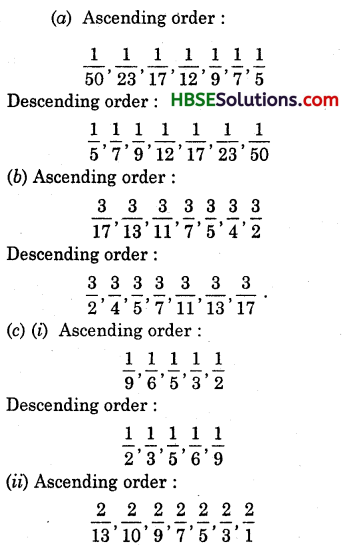


![]()
Try These (Page 198) :
Question 1.
My mother divided the apple into 4 equal parts. She gave me two parts and my brother one part. How much apple did she give both of us together ?
Solution:
Apple given to me = \(\frac{2}{4}\)
Apple given to my brother = \(\frac{1}{4}\)
∴ Apple given to both of us together = \(\frac{2}{4}+\frac{1}{4}\)
= \(\frac{2+1}{4}=\frac{3}{4}\)
Question 2.
The mother asked Neelu and her brother to pick stones from the wheat Neelu picked 1/4th of the total stones in it and her brother also picked up l/4th of the stones. How many stones both picked up together ?
Solution:
Stones picked up by Neelu
= 1/4th of the total stones
Stones picked up by her brother
= 1/4th of the total stones
∴ Stones picked up by both together
= \(\frac{1}{4}+\frac{1}{4}\)
= \(\frac{1+1}{4}=\frac{2}{4}\)
= \(\frac{1}{2}\) of the total stones.
Question 3.
Sohan was making a table. He made l/4th of the table by Monday. He made another l/4th on Tuesday and Wednesday. How much of the table has been made by Wednesday evening ?
Solution:
Table made on Monday = \(\frac{1}{4}\)
Table made on Tuesday & Wednesday = \(\frac{1}{4}\)
∴ Table made by Wednesday evening = \(\frac{1}{4}+\frac{1}{4}=\frac{2}{4}=\frac{1}{2}\)
Try These (Page 200) :
Question 1.
Add, with the help of a diagram :
(i) \(\frac{1}{8}+\frac{1}{8}\)
(ii) \(\frac{2}{5}+\frac{3}{5}\)
(iii) \(\frac{1}{12}+\frac{1}{12}+\frac{1}{12}\)
Solution:


![]()
Question 2.
What do we get when we do this \(\)?
Solution:
\(\frac{2}{5}+\frac{4}{5} ?\)
By Pictorially:

Using paper folding: Take a square piece of paper. Fold it by overlapping its edge AB and CD to get
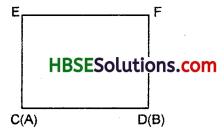
Again. refold it by taking
EF over C(A) D(B). Reopen it.

Now fold is vertically at two places to obtain three equal vertical portion as shown.
Shade \(\frac{1}{12}\) portion two times.
Now, we see \(\frac{1}{12}+\frac{1}{12}=\frac{2}{12}=\frac{1}{6}\)
Question 3.
Make 10 more examples of problems given in 1 and 2 above. Solve them with your friends.
Solution:
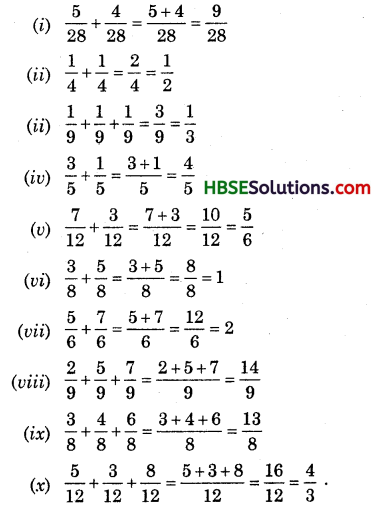
Try These (Page 201):
Question 1.
Find the difference between \(\frac{7}{4}\) and \(\frac{3}{4}\).
Solution:
\(\frac{7}{4}-\frac{3}{4}=\frac{7-3}{4}=\frac{4}{4}=1\)
![]()
Question 2.
Mother made a gud patti in a round shape. She divided it into 5 equal pieces. Seema ate one piece from it. If I ate another piece, how much was be left ?
Solution:
Gud patti in a round shape has been divided into 5 equal parts.
Each part = \(\frac{1}{5}\)
Seema ate one piece from it i.e., \(\frac{1}{5}\)
I ate another piece from it i.e.,\(\frac{1}{5}\)
Gud patti eaten by both of us = \(\frac{1}{5}+\frac{1}{5}=\frac{2}{5}\)
Part of gud patti left = \(1-\frac{2}{5}=\frac{5-2}{5}=\frac{3}{5}\)
Question 3.
My elder sister divided the water melon into 18 parts. I ate 7 out of them. My friend ate 4. How much did we eat ? How much more of water melon did I eat compared to my friend ? What amount of water melon remains ?
Solution:
Water melon is divided into 18 parts,.
∴ Each part = \(\frac{1}{18}\)
I ate 7 out of them i.e., \(\frac{7}{18}\)
My friend ate 4 out of them i.e., \(\frac{4}{18}\)
Water melon eaten by both of us = \(\frac{7}{18}+\frac{4}{18}=\frac{7+4}{18}=\frac{11}{18}\)
Difference between the two =\(\frac{7}{18}+\frac{4}{18}=\frac{7-4}{18}=\frac{3}{18}=\frac{1}{16}\)
I ate \(\frac{1}{6}\) more water melon as compared to my friend.
Amount of water melon remains =\(1-\frac{11}{18}=\frac{18-11}{18}=\frac{7}{18}\)
Question 4.
Make 5 problems of this type and solve them with friends.
(i) My mother divided the apple into 4 equal parts. She gave me 2 parts and my brother one part. How much apple was left ?
(ii) The mother asked Neelu and her brother to pick up stones from the wheat. Neelu picked up 1/4th of the total stones in it and her brother also picked up 1/4th of the stones. How many stones were left ?
(iii) Sohan was making a table. He made 1/4th of the table on Monday. He made another 1 /4th on Tuesday and Wednesday. How much table was left to be built ?
(iv) Sharmilahad \(\frac{5}{6}\) of a cake. She gave \(\frac{2}{6}\) out of that to her younger b
brother. How much cake is left with her ?
(v) My elder brother divided the water melon into 10 equal parts. He ate 8 out of them and gave me 2. How much more of water melon did he eat compared to me ? How much did we eat together ? What amount of water melon remains ?
Solution:
(i) Apple given to me = \(\frac{2}{4}\), apple given to my brother = \(\frac{1}{4}\)

(ii) Stones picked up by Neelu = \(\frac{1}{4}\)
Stones picked up by her brother = \(\frac{1}{4}\)
∴ Stones picked up by both

(iii) Table made on Monday = \(\frac{1}{4}\)
Table made on Tuesday and Wednesday = \(\frac{1}{4}\)
∴ Table made by Wednesday evening = \(\frac{1}{4}+\frac{1}{4}=\frac{2}{4}=\frac{1}{2}\)
∴ Table left to be made
= \(1-\frac{1}{2}=\frac{2-1}{2}=\frac{1}{2}\)
![]()
(iv) Sharmila had 5/6 of a cake and she
gave 2/6 to her brother.
Cake left with her
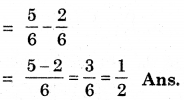
(v) Water melon is divided into 10 equal parts.
∴ Eachpart = \(\frac{1}{10}\)
My brother ate 8 out of them i.e., \(\frac{8}{10}\)
He gave me 2 out of 10 i.e., \(\frac{2}{10}\)
Difference between the two \([latex]\frac{8}{10}-\frac{2}{10}=\frac{8-2}{10}=\frac{6}{10}=\frac{3}{5}\)[/latex]
My brother ate \(\frac{3}{5}\) more water melon as compared to me.
Water melon eaten by both of us together
\(\frac{8}{10}+\frac{2}{10}=\frac{8+2}{10}=\frac{10}{10}=1\)
Amount of water melon remains = 1 – 1 = 0
i.e., the whole water melon is eaten by us.
Try These (Page 204)
Question 1.
Add \(\frac{2}{5}\) and \(\frac{3}{7}\)
Solution:
\(\frac{2}{5}+\frac{3}{7}\) We have L.C.M. (5, 7) = 35
\(\frac{2 \times 7+5 \times 3}{35}\)
[We have done this to find equivalent fractions]
\(\frac{14+15}{35}=\frac{29}{35}\)
Question 2.
Subtract \(\frac{2}{5}\) from \(\frac{5}{7}\)
Solution:
\(\frac{5}{7}-\frac{2}{5}\)
We have L.C.M. (7, 5) = 35
\(\frac{5 \times 5-7 \times 2}{35}\)
[We have done this to find equivalent fractions]
\(\frac{25-14}{35}\)
\(\frac{11}{5}\)
![]()
Try These (Page 206) :
Question.
(i) 2\(\frac{1}{5}\) and 3\(\frac{2}{6}\)
(ii) 2\(\frac{2}{3}\) from 5\(\frac{6}{7}\)
Solution:
